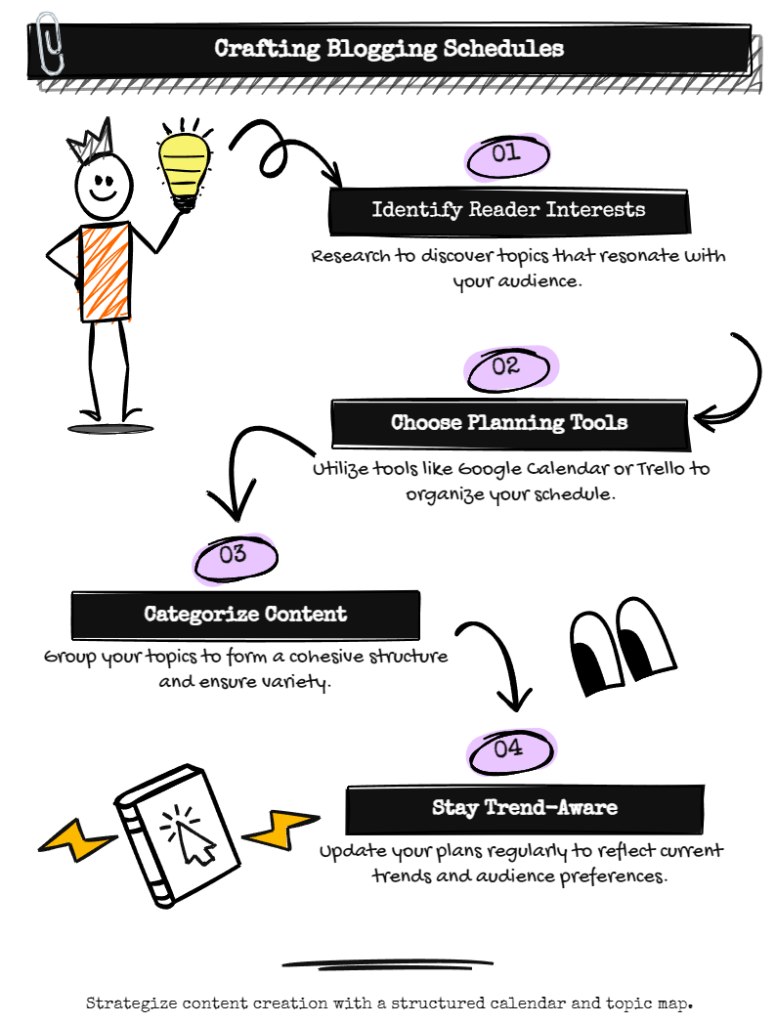

Construire un blog[3] Un calendrier de contenu et une carte thématique impliquent une planification minutieuse de votre contenu. Cela vous permet d'être toujours prêt à publier des articles frais que vos lecteurs apprécieront.
Commencez simplement - choisissez les principaux sujets sur lesquels vous souhaitez écrire. Ensuite, faites une recherche par mots-clés pour vous assurer que votre contenu correspond à ce que les gens recherchent. Cela vous aidera à élaborer votre carte des sujets, en regroupant les contenus similaires.
Parallèlement, élaborez votre calendrier de contenu. Vous pouvez utiliser des outils simples comme Google[4] Calendrier ou Trello pour garder une trace des sujets que vous traitez, de leur date de mise en ligne et des mots-clés que vous utilisez. Maintenez votre calendrier et votre carte des sujets à jour pour que votre blog reste frais et cohérent.
Vous en voulez plus ? Plongez plus profondément pour découvrir des techniques plus avancées qui vous aideront à rester organisé, à booster le référencement de votre blog et à faire passer votre jeu de blog à un niveau supérieur. Mais comment ces stratégies avancées peuvent-elles profiter à votre blog ? Restez à l'écoute pour le découvrir.
Qu'est-ce qu'un calendrier de contenu de blog et pourquoi les blogueurs en font-ils l'éloge ?
En termes simples, il s'agit d'un planificateur pour votre blog. Il s'agit en quelque sorte d'une feuille de route qui vous guide sur ce qu'il faut écrire ensuite, quand il faut le publier et qui se charge de la rédaction. Il s'agit d'un outil essentiel pour assurer la régularité de vos articles de blog et repérer les éléments manquants dans votre contenu.
Il s'agit en quelque sorte du centre de commandement de votre blog, qui vous donne une vue d'ensemble de votre parcours de contenu.
Mais qu'est-ce qui compose cette feuille de route ? Elle comporte des dates d'échéance pour vous permettre de rester sur la bonne voie, des mots-clés pour cibler votre rédaction et des liens vers vos ébauches. La création de contenu devient ainsi plus facile et plus directe.
Passons à la vitesse supérieure. Après avoir parlé des calendriers de blog, nous nous penchons sur un autre outil clé : la carte thématique. C'est une arme secrète qui organise le contenu et donne un coup de pouce à votre référencement. Qu'est-ce qu'elle a de si génial ?

Vous cherchez la solution idéale pour planifier et programmer votre contenu ? Il existe de nombreuses options pour vous aider à concevoir un calendrier de contenu et faciliter vos tâches de blogging. Parlons-en de quelques-unes, comme Google Calendar, CoSchedule et Trello. Chaque outil offre des fonctionnalités uniques conçues pour répondre à vos besoins spécifiques.
Comparons-les :
| Outil | Caractéristiques mises en évidence | Mieux adapté pour |
|---|---|---|
| Google Agenda | Gratuit et facile à utiliser, avec programmation et rappels | Les blogueurs travaillant de manière indépendante |
| CoSchedule | Vous permet de planifier le contenu, de programmer les médias sociaux et de travailler avec votre équipe. | Entreprises avec des équipes plus importantes |
| Trello | Offre des tableaux, des listes et des cartes qui peuvent être personnalisés pour une meilleure organisation. | Les personnes qui préfèrent la planification visuelle |
Le choix de l'outil qui vous convient le mieux dépend entièrement de vos besoins particuliers. Il est essentiel de choisir un outil qui corresponde à vos habitudes de travail et à vos besoins en matière de blogging.
Une fois que vous avez choisi vos outils pour élaborer votre calendrier de contenu, il est temps de définir vos sujets. C'est une façon intelligente de vous assurer que votre contenu est complet, pertinent et bien organisé.
Voici comment procéder :
Prêt à découvrir comment cela peut révolutionner votre stratégie de contenu ? Restez à l'écoute.
L'utilisation d'un calendrier de contenu de blog peut transformer la planification et la programmation de votre blog. Il s'agit en quelque sorte d'une feuille de route pour votre contenu, qui vous aide à suivre ce qui a été publié, ce qui est à venir et ce qui doit être complété. Vous pouvez en créer un sur Google Docs[2]Il est donc facile d'accès et d'utilisation.
La cohérence est essentielle lorsqu'il s'agit de bloguer. Un calendrier de contenu vous aide à rester sur la bonne voie, ce qui peut stimuler l'engagement des lecteurs et améliorer votre référencement.
Voici un exemple simple de ce à quoi pourrait ressembler un calendrier de contenu de blog :
| Date | Sujet | Mots clés |
|---|---|---|
Voyons quelques tactiques simples mais efficaces pour que votre blog se démarque.
Maintenant que vous connaissez ces stratégies, la question est de savoir quel est le secret pour les mettre en œuvre efficacement. Restez à l'écoute de notre prochain article de blog pour le découvrir !
Il est essentiel de comprendre comment se porte votre blog. C'est là que les analyses de blog entrent en jeu. Elles vous aident à voir ce qui fonctionne et ce qui ne fonctionne pas. Google Analytics[1] est un outil qui peut vous aider. Il montre comment les utilisateurs interagissent avec votre blog et met en évidence les points positifs et les points à améliorer. Vous pouvez examiner des éléments tels que le nombre de personnes qui consultent vos pages, la durée de leur visite et la rapidité avec laquelle elles quittent votre site.
En gardant un œil sur les mots-clés et le trafic de recherche, vous obtenez une vision claire de la portée de votre blog. L'ajout de liens de suivi et de paramètres UTM peut vous aider à voir comment se comportent les différents canaux de marketing. Il est essentiel de consulter régulièrement vos données d'analyse. Cela vous permet de repérer les tendances, d'adapter votre stratégie de contenu et de faire des choix éclairés pour vos futurs articles de blog.
Maintenant que nous avons discuté de l'importance de garder un œil sur les progrès de votre blog, nous allons nous plonger dans des histoires vraies qui montrent des tactiques gagnantes dans le domaine du blogging. Ces histoires permettent de comprendre comment un calendrier de blogage bien planifié et une liste de sujets bien pensée peuvent guider votre aventure dans le domaine du blogging.
Si l'idée de la recherche de mots-clés et de l'optimisation du contenu vous semble insurmontable, nous sommes là pour vous aider. Nos spécialistes sont prêts à élaborer une stratégie de référencement qui répond à vos besoins et objectifs uniques. Prenez contact avec nous dès maintenant via notre page de contact ou discutez avec nous instantanément sur WhatsApp pour une assistance rapide et professionnelle.
Naviguer dans le monde des blogs n'est pas une tâche facile. Il comporte son lot de problèmes. L'un d'entre eux est la pression exercée pour créer en permanence un contenu frais et attrayant pour les lecteurs et pour figurer en bonne place dans les résultats des moteurs de recherche. Mais ne vous inquiétez pas, il existe des moyens de contourner ce problème. L'une d'entre elles consiste à trouver constamment de nouvelles idées et à s'inspirer d'un large éventail de sources.
Une autre pierre d'achoppement est l'angoisse de la page blanche. Il s'agit d'un problème courant qui peut être résolu en explorant de nouveaux concepts et en expérimentant différents formats de contenu.
Il est également essentiel de bien gérer son temps. Pour ce faire, vous pouvez fixer des délais réalisables et utiliser des outils tels que des calendriers de contenu pour organiser votre travail.
Il est également indispensable de se tenir au courant des dernières tendances du secteur. Il faut faire preuve d'ouverture d'esprit et être capable d'adapter son plan de contenu en fonction des besoins.
Pour résumer ces solutions aux défis des blogs dans un simple tableau :
| Problème | Fixer | Outils utiles |
|---|---|---|
| Création de contenu | Trouver de nouvelles idées, s'inspirer d'un large éventail d'idées | - |
| Blocage de l'écrivain | Explorer de nouveaux concepts, tester différents formats | - |
| Gestion du temps | Fixer des délais réalisables, organiser les tâches | Calendriers de contenu |
| Tendances de l'industrie | Tenir à jour, être flexible | - |
| Engager les lecteurs | Utiliser un contenu interactif, Intégrer le retour d'information | - |
Si vous souhaitez mettre en place un calendrier de contenu pour votre blog, c'est assez facile. Vous pouvez utiliser des outils simples comme Google Calendar ou Trello. Ensuite, assurez-vous d'avoir un plan pour publier régulièrement des articles. Ainsi, votre contenu restera frais et cohérent. N'oubliez pas de vérifier et de mettre à jour votre calendrier fréquemment pour que tout se passe bien.
Vous pouvez créer une carte de contenu en présentant visuellement votre contenu de manière à ce qu'il soit facile à comprendre. Commencez par classer votre contenu par groupes. Ces groupes peuvent être basés sur des thèmes, des destinataires ou sur la place qu'ils occupent dans votre stratégie de communication. client[5]de l'utilisateur. Veillez à ce que votre carte soit interactive, afin que vous puissiez modifier votre plan de contenu en cas de besoin. Et devinez quoi ?
Un plan de contenu de blog est comme une feuille de route pour votre blog. Il vous aide à décider de ce que vous allez écrire, du moment où vous allez le publier et de la manière dont il sera structuré. En d'autres termes, il s'agit d'un plan qui vous aide à rester organisé, à faire en sorte que votre contenu corresponde aux attentes de votre public et à rendre votre blog plus convivial pour les moteurs de recherche. De cette manière, votre blog peut attirer plus de lecteurs et les inciter à revenir. Et le meilleur ? Il vous facilite grandement la tâche.
Un calendrier de contenu a besoin de quelques éléments clés. Tout d'abord, l'essentiel : quel est le titre du blog ? Quand sera-t-il publié ? Qui l'écrit ? Ensuite, il faut s'assurer que la fréquence des publications est planifiée. Enfin, réfléchissez aux personnes pour lesquelles vous écrivez. Adaptez votre contenu à leurs besoins.